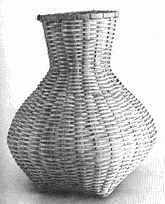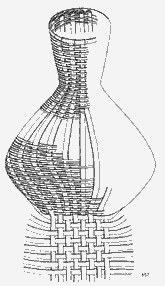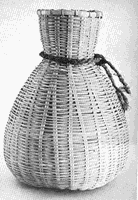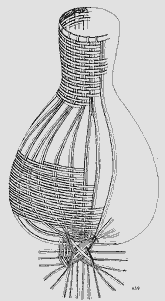| Product 1:
 This is a
fish basket (fig.655), the square base is woven in an open basket weave with 15 strips of
bamboo, seven in one direction and eight at right angles to them. This is a
fish basket (fig.655), the square base is woven in an open basket weave with 15 strips of
bamboo, seven in one direction and eight at right angles to them.  The strips extend
outwards from all sides of the base so that they can be turned up to form the stakes for
the body of the basket. The corners of the base are prominent because the strips are bent
upwards at that point. The distance between the stakes is varied according to the shape
required so that they are farthest apart at the maximum diameter of the basket. The strips extend
outwards from all sides of the base so that they can be turned up to form the stakes for
the body of the basket. The corners of the base are prominent because the strips are bent
upwards at that point. The distance between the stakes is varied according to the shape
required so that they are farthest apart at the maximum diameter of the basket.
The narrow neck is formed by
overlapping two stakes, thus reducing the total number by half. As there are an even
number of stakes, two strips of horizontal rings. The stakes are folded over at the top
rim and tied to an additional ring of bamboo (fig.657).
Product 2:
 The fish basket has an interesting base
(fig.658). Six strips used in two sets of three at right angles are interwoven in a loose
basket weave. The fish basket has an interesting base
(fig.658). Six strips used in two sets of three at right angles are interwoven in a loose
basket weave. Another base is made
with eight additional strips arranged to form four curved diagonals. The two bases are
pinned together with diagonal bamboo sticks. The bamboo strips of both bases extend beyond
the base, and these are turned upwards to become the stakes for the body of the basket.
One additional stake is introduced in one corner so that there are an odd number of
stakes.(fig. 659). Another base is made
with eight additional strips arranged to form four curved diagonals. The two bases are
pinned together with diagonal bamboo sticks. The bamboo strips of both bases extend beyond
the base, and these are turned upwards to become the stakes for the body of the basket.
One additional stake is introduced in one corner so that there are an odd number of
stakes.(fig. 659).
Product 3:
 The fish
basket is used to store freshly caught fish (fig.660). It has an interesting form that
results from its unique construction. Strips of bamboo are interwoven to create a
rectangular base and are turned upwards at the periphery of the base to provide the
vertical members for the body of the basket. The corners thus formed are reinforced with a
cane binding and the base itself is strengthened along its diagonals by two bamboo
splints. The fish
basket is used to store freshly caught fish (fig.660). It has an interesting form that
results from its unique construction. Strips of bamboo are interwoven to create a
rectangular base and are turned upwards at the periphery of the base to provide the
vertical members for the body of the basket. The corners thus formed are reinforced with a
cane binding and the base itself is strengthened along its diagonals by two bamboo
splints.
Weave
structure
The body of the basket is created
by a horizontal strip of bamboo weaving a twill pattern between the vertical members upto
a certain height. At this point, the weft strip is ended, and the vertical members are
grouped into sets of four, each set acting as a single member. Corners are created at the
centres of the short side of the rectangular body by bending three sets on either side of
these centres in opposite to it. The vertical members remaining on the longer side of the
rectangular body continue upwards to form the neck after being woven into the sets that
move horizontally.
This interweaving creates an
inclined surface that meets the narrow neck. The ends of the horizontally arranged
vertical staves overlap at the centre on the longer side, on either side of the neck. This
construction causes a reduction of the number of vertical staves at the neck. Another
horizontal strip resumes weaving between these staves to form the neck upto the rim. This
is then strengthened by twisting the ends into a ring and tying it to a thin bamboo ring. |
 This is a
fish basket (fig.655), the square base is woven in an open basket weave with 15 strips of
bamboo, seven in one direction and eight at right angles to them.
This is a
fish basket (fig.655), the square base is woven in an open basket weave with 15 strips of
bamboo, seven in one direction and eight at right angles to them.  The strips extend
outwards from all sides of the base so that they can be turned up to form the stakes for
the body of the basket. The corners of the base are prominent because the strips are bent
upwards at that point. The distance between the stakes is varied according to the shape
required so that they are farthest apart at the maximum diameter of the basket.
The strips extend
outwards from all sides of the base so that they can be turned up to form the stakes for
the body of the basket. The corners of the base are prominent because the strips are bent
upwards at that point. The distance between the stakes is varied according to the shape
required so that they are farthest apart at the maximum diameter of the basket. The fish basket has an interesting base
(fig.658). Six strips used in two sets of three at right angles are interwoven in a loose
basket weave.
The fish basket has an interesting base
(fig.658). Six strips used in two sets of three at right angles are interwoven in a loose
basket weave. Another base is made
with eight additional strips arranged to form four curved diagonals. The two bases are
pinned together with diagonal bamboo sticks. The bamboo strips of both bases extend beyond
the base, and these are turned upwards to become the stakes for the body of the basket.
One additional stake is introduced in one corner so that there are an odd number of
stakes.(fig. 659).
Another base is made
with eight additional strips arranged to form four curved diagonals. The two bases are
pinned together with diagonal bamboo sticks. The bamboo strips of both bases extend beyond
the base, and these are turned upwards to become the stakes for the body of the basket.
One additional stake is introduced in one corner so that there are an odd number of
stakes.(fig. 659). The fish
basket is used to store freshly caught fish (fig.660). It has an interesting form that
results from its unique construction. Strips of bamboo are interwoven to create a
rectangular base and are turned upwards at the periphery of the base to provide the
vertical members for the body of the basket. The corners thus formed are reinforced with a
cane binding and the base itself is strengthened along its diagonals by two bamboo
splints.
The fish
basket is used to store freshly caught fish (fig.660). It has an interesting form that
results from its unique construction. Strips of bamboo are interwoven to create a
rectangular base and are turned upwards at the periphery of the base to provide the
vertical members for the body of the basket. The corners thus formed are reinforced with a
cane binding and the base itself is strengthened along its diagonals by two bamboo
splints.